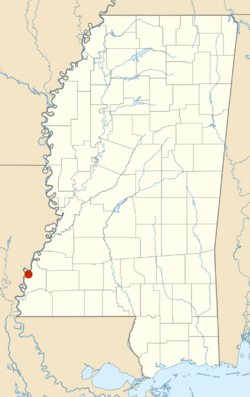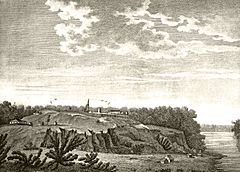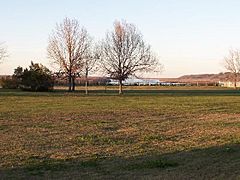Natchez revolt facts for kids
The Natchez revolt, or the Natchez massacre, was an attack by the Natchez Native American people on French colonists near present-day Natchez, Mississippi, on November 29, 1729. The Natchez and French had lived alongside each other in the Louisiana colony for more than a decade prior to the incident, mostly conducting peaceful trade and occasionally intermarrying. After a period of deteriorating relations and warring, Natchez leaders were provoked to revolt when the French colonial commandant, Sieur de Chépart, demanded land from a Natchez village for his own plantation near Fort Rosalie. The Natchez plotted their attack over several days and managed to conceal their plans from most of the French; colonists who overheard and warned Chépart of an attack were considered untruthful and were punished. In a coordinated attack on the fort and the homesteads, the Natchez killed almost all of the Frenchmen, while sparing most of the women and enslaved Africans. Approximately 230 colonists were killed overall, and the fort and homes were burned to the ground.
When the French in New Orleans, the colonial capital, heard the news of the massacre, they feared a general Indian uprising and were concerned that the Natchez might have conspired with other tribes. They first responded by ordering a massacre of the Chaouacha people – who had played no role in the revolt – and wiped out their entire village. The French and their Choctaw allies then retaliated against the Natchez villages, capturing hundreds of Natchez and selling them into slavery, although many managed to escape to the north and take refuge among the Chickasaw people. The Natchez waged low-intensity warfare against the French over the following years, but retaliatory expeditions against Natchez refugees among the Chickasaw in 1730 and 1731 forced them to move on and live as refugees among the Creek and Cherokee tribes. By 1741, the Natchez had established a town in the northern parts of the Upper Creek Nation. There, with permission from the Abihka, they reconstituted their town and were signatories in the 1790 Treaty of New York and the 1796 Treaty of Colerain. They remain a constituent tribe of the Muscogee (Creek) Nation.
The attack on Fort Rosalie destroyed some of the Louisiana colony's most productive farms and endangered shipments of food and trade goods on the Mississippi River. As a result, the French state returned control of Louisiana from the Company of the Indies to the crown in 1731, as the company had been having trouble running the colony. Louisiana governor Étienne Perier was held responsible for the massacre and its aftermath, and he was recalled to France in 1732.
Background

While descending the Mississippi River in 1682, Robert de La Salle became the first Frenchman to encounter the Natchez and declared them an ally. The Natchez were sedentary and lived in nine semi-autonomous villages; the French considered them the most civilized tribe of the region. By 1700 the Natchez' numbers had been reduced to about 3,500 by the diseases that ravaged indigenous populations in the wake of contact with Europeans, and by 1720 further epidemics had halved that population. Their society was strictly divided into a noble class called "the Suns" (Natchez: ʔuwahʃiːɫ) and a commoner class called in French "the Stinkards" (Natchez: miʃmiʃkipih). Between 1699 and 1702, the Natchez received the explorer Pierre Le Moyne d'Iberville in peace and allowed a French missionary to settle among them. At this time, the Natchez were at war with the Chickasaw people, who had received guns from their British allies, and the Natchez expected to benefit similarly from their relationship with the French. Nonetheless, the British presence in the territory led the Natchez to split into pro-British and pro-French factions. The central village, called Natchez or the Grand Village, was led by the paramount chief Great Sun (Natchez: ʔuwahʃiːɫ liːkip) and the war chief Tattooed Serpent (Serpent Piqué in the French sources, Natchez Obalalkabiche), both of whom were interested in pursuing an alliance with the French.
First, Second, and Third Natchez Wars
The first conflict between the French and the Natchez took place in 1716, when the governor of Louisiana, Antoine Laumet de La Mothe, sieur de Cadillac, passed through Natchez territory and neglected to renew the alliance by smoking the peace calumet. The Natchez reacted to this slight by killing four French traders. Cadillac sent his lieutenant Jean-Baptiste Le Moyne de Bienville to punish the Natchez. He deceived the Natchez leaders by inviting them to attend a parley, where they were ambushed and captured; he then forced the Natchez to exchange their leaders for the culprits who had attacked the French. A number of random Natchez from the pro-British villages were executed. This caused French–Natchez relations to deteriorate further. As part of the terms of the peace accord following this First Natchez War, the Natchez promised to supply labor and materials for the construction of a fort for the French.
By 1717, French colonists had established Fort Rosalie and a trading post in what is now Natchez, Mississippi, seeking to protect the their trade monopoly in the region from British incursions. The French also granted numerous concessions for large tobacco plantations, as well as smaller farms, on land acquired from the Natchez. Relations between Natchez and colonists were generally friendly—some Frenchmen even married and had children with Natchez women—but there were tensions. There were reports of colonists abusing Natchez, forcing them to provide labor or goods, and as more colonists arrived, their concessions gradually encroached on Natchez lands.
From 1722 to 1724, brief armed conflicts between the Natchez and French were settled through negotiations between Louisiana governor Bienville and Natchez war chief Tattooed Serpent. In 1723, Bienville was informed that some Natchez had harassed villagers, and he razed the Natchez village of White Apple and enslaved several villagers, only to discover that the alleged harassment had been faked by the colonists to frame the Natchez. One of the later skirmishes in 1724 consisted of the murder of a Natchez chief's son by a colonist, to which the Natchez responded by killing a Frenchman named Guenot. Bienville then sent French soldiers from New Orleans to attack the Natchez at their fields and settlements, and the Natchez surrendered. Their plea for peace was met following the execution of one of their chiefs by the French.
Chronicler Le Page du Pratz, who lived among the Natchez and was a close friend of Tattooed Serpent, records that he once asked his friend why the Natchez were resentful towards the French. Tattooed Serpent answered that the French seemed to have "two hearts, a good one today, and tomorrow a bad one", and proceeded to tell how Natchez life had been better before the French arrived. He finished by saying, "Before the arrival of the French we lived like men who can be satisfied with what they have, whereas today we live like slaves, who are not suffered to do as they please." The most faithful ally of the French, Tattooed Serpent died in 1725, another blow to the relations between the Natchez and the colonists.
In August 1726, the arrival of the new governor, Étienne Perier, sparked new tensions. Perier broke with Bienville's policy of diplomatic engagement with neighboring tribes, including the Natchez, and refused to recognize Native American ownership of their traditional lands. To oversee Fort Rosalie and the Natchez settlement, Perier appointed the Sieur de Chépart, who was described by as "rapacious, haughty, and tyrannical," abusing soldiers, settlers, and the Natchez alike. Perier and Chépart entered a partnership to develop a large plantation on Natchez land.
According to archaeologist Karl Lorenz, who excavated several Natchez settlements, another factor that complicated relations between the Natchez and the colonists was the fact that the French did not understand the Natchez's political structure. The French assumed that the Great Sun, the chief of the Grand Village, held sway over all other Natchez villages. In truth, each village was semi-autonomous and the Great Sun's power only extended to the villages of Flour and Tioux (with which the Grand Village was allied) and not to the three pro-British villages of White Apple, Jenzenaque and Grigra. When the Great Sun died in 1728 and was succeeded by his inexperienced nephew, the pro-British villages became more powerful than the pro-French villages centered at Natchez.
Commandant Chépart
In 1728, Chépart, the commandant of Fort Rosalie, was brought to New Orleans and put on trial before the Superior Council for abuse of power. Chépart was saved from punishment, according to Horatio Bardwell Cushman, by "the interference of influential friends," and Governor Perier pardoned Chépart, restoring him to his command. Chépart returned to Fort Rosalie and continued to oppress and abuse the Indians.
Looking to further his and Perier's business ambitions, Chépart told the Natchez in spring 1729 that he wished to seize land for a plantation in the center of White Apple, where the Natchez had a temple of their people's graves, planting a missionary cross on the land to indicate he was acting on Perier's orders. By this point, most of the colonists disapproved of Chépart's actions, including Jean-François-Benjamin Dumont de Montigny, a French historian who wrote that Chépart's demand marked the first time that a French colonial leader had simply claimed Natchez land as his own, without prior negotiation.
When the Natchez began to protest the seizure of their land for the plantation, Chépart said he would burn down the temple that contained their ancestors' graves. In response to this threat, the Natchez seemed to promise to cede the land, wrote Dumont de Montigny, but only if they were given until after the harvest to relocate their temple and graves. Chépart agreed to give them the time in exchange for pelts, oil, poultry, and grain — a request the Natchez promised to fulfill later.
Attack

After Chépart announced to the Natchez the complete removal of the tribe from their land in the near future, the Natchez began to prepare for a strike on the French at Fort Rosalie, borrowing firearms from some French colonists with promises to go hunting and to share the game with the guns' owners. Some French men and women overheard the Natchez planning such an attack. According to Le Page du Pratz, it was the Natchez female chief Tattooed Arm who attempted to alert the French of an upcoming attack led by her rivals at White Apple. When colonists told Chépart, he disregarded them and placed some in irons on the night before the massacre.
On the morning of November 29, 1729, the Natchez came to Chépart with corn, poultry, and deerskins, also carrying with them a calumet — well known as a peace symbol. The commandant was certain that the Natchez had no violent intentions, and he challenged those who had warned of an attack to prove that the rumors were accurate.
While Chépart was accepting the goods, the Natchez started firing, giving the signal for a coordinated attack on Fort Rosalie and on the outlying farms and concessions in the area now covered by the city of Natchez. Chépart ran to call his soldiers to arms, but they had already been killed. The details of the attack are mostly unknown, as chroniclers such as Le Page du Pratz, who talked with several eyewitnesses, stated that the events were "simply too horrific" to recount.
The Natchez had prepared by seizing the galley of the Company of the Indies anchored on the river so that no Frenchmen could board it and attempt to escape. They had also stationed warriors on the other side of the river to intercept those who might flee in that direction. The commandant at the Yazoo trading post of Fort St. Pierre, Monsieur du Codère, was visiting Fort Rosalie with a Jesuit priest when they heard gunshots. They turned around to return to their ship, but warriors caught up with them, killing them.
The Natchez killed almost all of the 150 Frenchmen at Fort Rosalie, and only about 20 managed to escape, some fleeing to New Orleans. Most of the dead were unarmed. Women, children, and enslaved Africans were mostly spared; many were locked inside a house on the bluff, guarded by several warriors, from where they could see the events. According to Dumont de Montigny's account of the attack, women seen defending their husbands from the violence, or trying to avenge them, were taken captive or killed. A year after the event, the tally of dead was put at 138 men, 35 women, and 56 children, or approximately 230 overall. Some scholars argue that the Natchez spared the enslaved Africans due to a general sense of affinity between the Natchez and the Africans; some slaves even joined the Natchez, while others took the chance to escape to freedom. A group of Yazoo people who were accompanying Commandant du Codère remained neutral during the conflict but were inspired by the Natchez revolt. When they returned to Fort St. Pierre, they destroyed the fort, killing the Jesuit priest and 17 French soldiers.
The Natchez lost only about 12 warriors during the attack. Eight warriors died attacking the homestead of the La Loire des Ursins family, where the men had been able to prepare a defense against the intruding Natchez.
Chépart himself was taken captive by the Natchez, who were at first unsure what to do with him, but finally decided that he should be killed by a stinkard — a member of the lowest caste in the tribe's hierarchy. The Natchez kept two Frenchmen alive, a carter named Mayeux who was made to carry all the goods of the French to the Great Village, and a tailor named Le Beau who was employed by the Natchez to refit the colonists' clothing to new owners. They set fire to the fort, the store, and all the homesteads, burning them to the ground.



